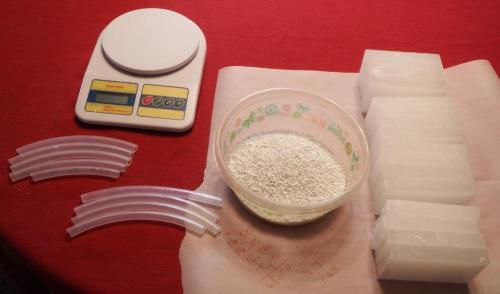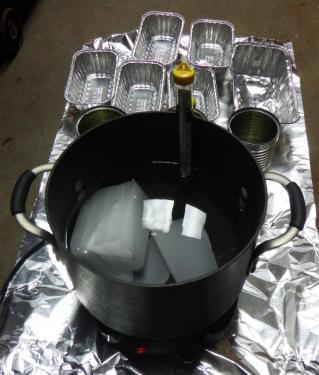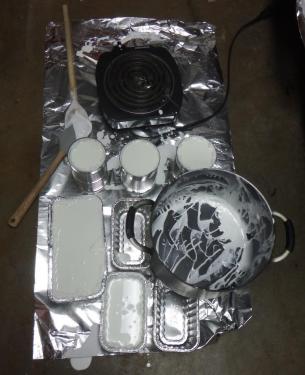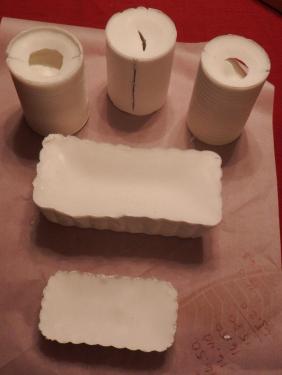11-08-2015, 01:51 PM
As noted in another post I've decided to try making machinable wax. Got the ingredients together. I weighed them not so much for "accuracy" as to keep a record for repeatably.
65.2 oz. paraffin
16.3 oz. virgin HDPE pellets
3.3 EVA - ethylene-vinyl acetate tubing

I set up the hotplate, kettle and molds on the garage floor ...

Turned on the hotplate and and started adding blocks of paraffin. They started to melt and eventually I got them all in the kettle. The temperature seem to be pretty stable around 165F (75C) during this process.

After all the paraffin had melted I turned the hotplate up and as the paraffin temperature rose past 300F (150C) added a very small amount of HDPE pellets. It quickly became obvious that the paraffin was not hot enough to melt the HDPE as the pellets just sank to the bottom of the kettle. But once on the bottom the heat of the kettle bottom was enough to soften them into [warning, very technical term ahead] a 'goo'. I continued to sure the paraffin, scrape the goo around the bottom of the kettle and allow the temperature to rise. Eventually it got up to 350F (175C) and it looked like HDPE was beginning to dissolve.

I let the mixture continue to heat. Even thought the documented melting point of HDPE is 266F (130C) it looked like there was some, but no a lot happening at 350F (175C). I continued to add HDPE pellets and stir the goo. I did not have a clue about the EVA tubing. It was recommended as an addition to make the HDPE less brittle and was suppose to melt at reasonably [in this context anyway] low temperatures. As it turns out the tubing was probably not a good source for EVA. I put them into the mixture and eventually brought the tempurature up to 410F (210C) which seems to have done the trick for the HDPE but was not enough to dissolve the tubing. True, it went thru an "in serious need of Viagra" stage and eventually reached the 'goo' stage but I was not able to get all of it to dissolve. Additional research for a source of EVA is a project take-away.
Not wanting to tempt fate with higher temperatures or additional time I used a metal soup ladle [Goodwill was a major tool supplier for this project] and filled the molds I had laid out. All in all the "turn the hotplate on to pour" time seemed to be about 90 minutes.

After ensuring that everything seemed to be safely cooling I made a side trip ... metal plate gift ... Upon return I noticed that the round pours had a serious case of the 'voids' on the top but the rectangular items, though they looked like they had concave tops, did not seem to suffer as much. I used a Dremel cutoff wheel to remove the round cans from around the wax. The final results ...

Now all I need to do is see how well this works in the lathe and my little mill.
It is suggested that machinable wax is reusable, assuming you can gather up all of the swarf and small chunks. The plan for that is to use a shopvac that I got for free on the local FreeCycle list. I cleaned it up and it will be dedicated to machinable wax cleanup, unlike the regular shopvac which is dedicated to anything that is small enough to fit up the hose and not fastened down.
Anyway, that is the plan,
Arvid
65.2 oz. paraffin
16.3 oz. virgin HDPE pellets
3.3 EVA - ethylene-vinyl acetate tubing
I set up the hotplate, kettle and molds on the garage floor ...
Turned on the hotplate and and started adding blocks of paraffin. They started to melt and eventually I got them all in the kettle. The temperature seem to be pretty stable around 165F (75C) during this process.
After all the paraffin had melted I turned the hotplate up and as the paraffin temperature rose past 300F (150C) added a very small amount of HDPE pellets. It quickly became obvious that the paraffin was not hot enough to melt the HDPE as the pellets just sank to the bottom of the kettle. But once on the bottom the heat of the kettle bottom was enough to soften them into [warning, very technical term ahead] a 'goo'. I continued to sure the paraffin, scrape the goo around the bottom of the kettle and allow the temperature to rise. Eventually it got up to 350F (175C) and it looked like HDPE was beginning to dissolve.
I let the mixture continue to heat. Even thought the documented melting point of HDPE is 266F (130C) it looked like there was some, but no a lot happening at 350F (175C). I continued to add HDPE pellets and stir the goo. I did not have a clue about the EVA tubing. It was recommended as an addition to make the HDPE less brittle and was suppose to melt at reasonably [in this context anyway] low temperatures. As it turns out the tubing was probably not a good source for EVA. I put them into the mixture and eventually brought the tempurature up to 410F (210C) which seems to have done the trick for the HDPE but was not enough to dissolve the tubing. True, it went thru an "in serious need of Viagra" stage and eventually reached the 'goo' stage but I was not able to get all of it to dissolve. Additional research for a source of EVA is a project take-away.
Not wanting to tempt fate with higher temperatures or additional time I used a metal soup ladle [Goodwill was a major tool supplier for this project] and filled the molds I had laid out. All in all the "turn the hotplate on to pour" time seemed to be about 90 minutes.
After ensuring that everything seemed to be safely cooling I made a side trip ... metal plate gift ... Upon return I noticed that the round pours had a serious case of the 'voids' on the top but the rectangular items, though they looked like they had concave tops, did not seem to suffer as much. I used a Dremel cutoff wheel to remove the round cans from around the wax. The final results ...
Now all I need to do is see how well this works in the lathe and my little mill.
It is suggested that machinable wax is reusable, assuming you can gather up all of the swarf and small chunks. The plan for that is to use a shopvac that I got for free on the local FreeCycle list. I cleaned it up and it will be dedicated to machinable wax cleanup, unlike the regular shopvac which is dedicated to anything that is small enough to fit up the hose and not fastened down.
Anyway, that is the plan,
Arvid




